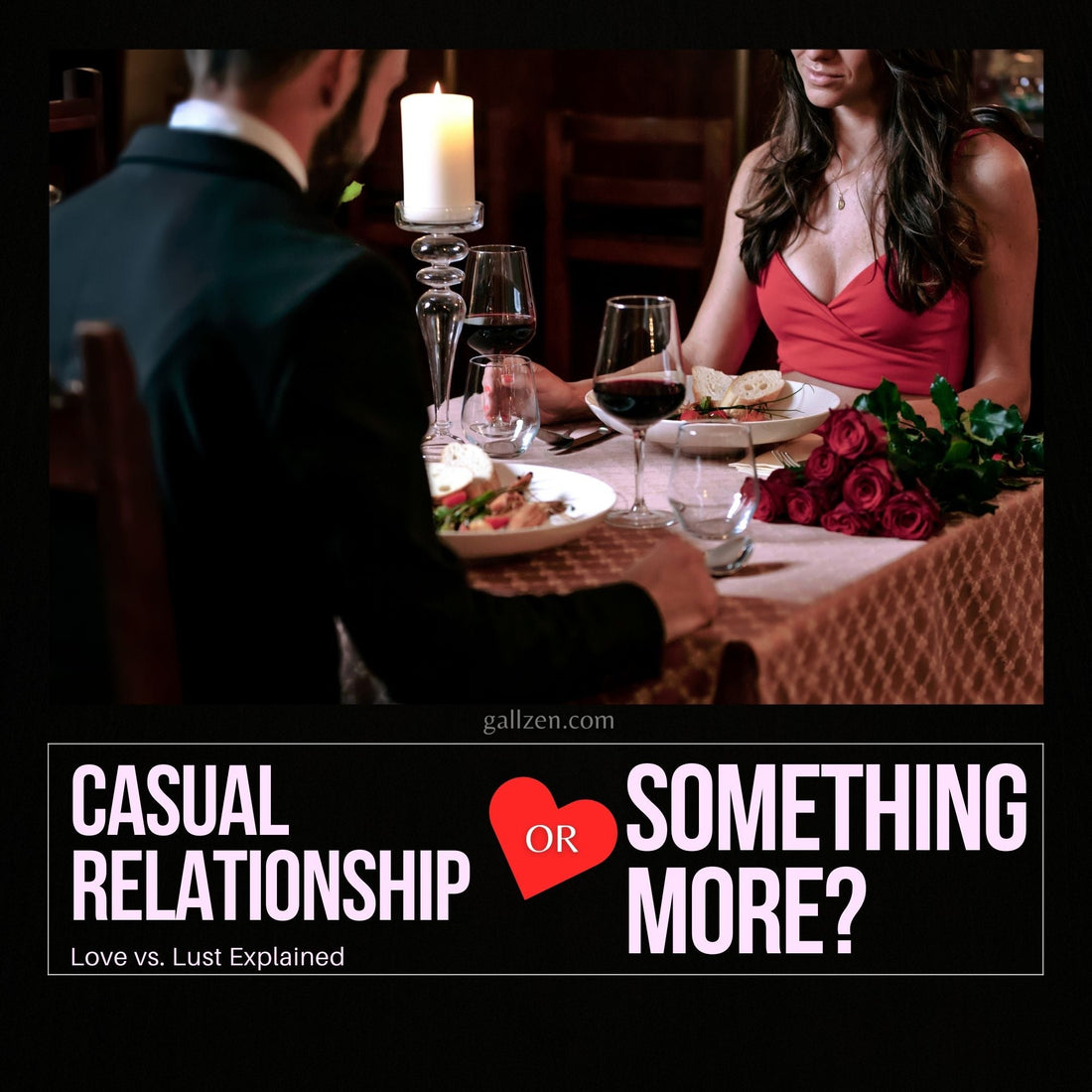
Casual Relationship or Something More? Love vs. Lust Explained
Share
Introduction
Have you ever found yourself wondering if your relationship is based on real love or just a temporary physical attraction? It’s a common dilemma, and many people struggle to differentiate between love and lust. While both emotions can feel intense, they are fundamentally different in how they affect a relationship in the long run.

Understanding the difference between love and lust can help you make better decisions in your relationships. Lust is primarily physical and often short-lived, while love goes deeper, creating a lasting emotional bond. But can lust turn into love? Can a casual relationship evolve into something meaningful? Let’s explore the key differences between these two powerful emotions.
1. Understanding Lust: The Physical Attraction
Lust is a strong, overwhelming physical attraction that often drives the initial stages of a relationship. It is fueled by hormones like dopamine and testosterone, which trigger feelings of excitement, desire, and even obsession.

Lust is not necessarily bad—it’s a natural human experience. However, it is often mistaken for love because of its intensity. In reality, lust is more about fulfilling physical desires rather than forming a deep emotional bond.
The Signs of Lust
How do you know if what you're feeling is lust rather than love? Here are some telltale signs:
- Intense Physical Attraction – Your focus is primarily on your partner’s looks and physical intimacy rather than their personality or emotional needs.
- Short-Term Excitement – The relationship feels exciting but lacks deeper emotional discussions or long-term plans.
- Lack of Emotional Connection – Conversations are often surface-level, and there’s little effort to truly understand each other beyond the physical aspect.
Lust can be thrilling, but it often fades over time if there’s no emotional depth to support the relationship.
2. Defining Love: The Emotional Connection
Love, unlike lust, is built on emotional intimacy, trust, and mutual understanding. It grows over time and is not solely based on physical attraction. True love involves genuine care for another person’s well-being, even beyond romantic feelings.

Love brings emotional security and a sense of deep connection. It is about sharing values, dreams, and life experiences rather than just physical pleasure.
The Signs of Love
If you’re wondering whether what you’re feeling is love, here are some signs:
- Emotional Depth and Vulnerability – You can openly share your thoughts, fears, and dreams with your partner.
- Genuine Care and Concern – You prioritize their happiness and well-being, even when there’s no benefit to you.
- Long-Term Vision – You see a future together and share mutual goals and aspirations.
Love is not just about how someone makes you feel—it’s about wanting the best for them and building a meaningful connection that stands the test of time.
3. Lust vs. Love: Key Differences
To make things clearer, here are some key differences between love and lust:

4. Can Lust Turn Into Love?
One of the biggest questions people have is whether a relationship that starts with lust can develop into real love. The short answer? Yes, but it depends on a few key factors.

Attraction is often the spark that brings two people together, but for a relationship to transition from lust to love, there must be more than just physical chemistry. Here’s what it takes for lust to evolve into love:
- Time and Effort – If both partners take the time to truly know each other beyond physical attraction, the relationship has a chance to deepen.
- Mutual Respect – Love requires a foundation of respect and understanding. If you only see your partner as a source of physical pleasure, love is unlikely to develop.
- Emotional Connection – As intimacy grows beyond the physical, feelings of care, trust, and emotional security should emerge.
- Shared Values and Goals – A lasting relationship requires alignment in values, priorities, and long-term life goals.
If a relationship remains purely physical with no emotional growth, it’s likely to stay in the realm of lust. However, if you and your partner make an effort to build something deeper, there’s potential for love to develop over time.
5. Casual Relationships: When Lust is Enough
Not everyone is looking for love—sometimes, people are simply interested in casual relationships based on mutual attraction. This isn’t necessarily a bad thing, as long as both partners are on the same page.

What Defines a Casual Relationship?
A casual relationship is one that lacks deep emotional commitment or long-term expectations. Key characteristics include:
- Focus on Physical Intimacy – The relationship is centered around attraction rather than emotional connection.
- No Expectations for the Future – There’s no pressure to define the relationship or make long-term commitments.
- Limited Emotional Involvement – Feelings are kept at a surface level to avoid attachment.
- Freedom to See Other People – Many casual relationships are non-exclusive, allowing both partners to date others.
Casual relationships work best when both partners are honest about their intentions and respect each other’s boundaries. Problems arise when one person starts developing deeper feelings while the other remains emotionally detached.
6. Signs Your Relationship is More Than Just Lust
If you’re unsure whether your relationship is based on love or lust, here are some key signs that indicate your connection goes beyond physical attraction:

- You Enjoy Spending Time Together Beyond Intimacy – If your best moments together aren’t just in the bedroom, it’s a strong sign of love.
- You Support Each Other’s Personal Growth – In a loving relationship, both partners encourage each other’s dreams and ambitions.
- You Feel Emotionally Secure – Love brings a sense of stability, trust, and comfort. If you feel emotionally safe with your partner, it’s more than just lust.
- You Can Be Vulnerable – True love allows you to open up about fears, insecurities, and emotions without fear of judgment.
- You Prioritize Their Happiness – Love is selfless, and if you genuinely care about your partner’s well-being, your relationship has deeper emotional roots.
Recognizing these signs can help you understand the nature of your relationship and determine whether it has the potential for long-term love.
7. The Role of Communication in Love and Lust
One of the biggest differences between love and lust is how well partners communicate with each other. Lust-driven relationships tend to focus on physical interactions, while love-driven relationships involve deep, meaningful conversations.

Why Open Conversations Are Crucial
Honest communication is the foundation of any healthy relationship. It helps partners:
- Express Their Needs and Expectations – Being clear about what you want prevents misunderstandings.
- Resolve Conflicts Effectively – Disagreements are natural, but couples in love work through them with respect and compromise.
- Build Emotional Intimacy – Talking about fears, dreams, and life goals strengthens the emotional bond.
- Avoid Heartbreak – If one person wants love while the other is only interested in lust, clear communication can prevent emotional pain.
If your relationship lacks meaningful conversations and emotional openness, it may be based more on lust than love.
8. Psychological and Scientific Perspectives on Love vs. Lust
Science provides fascinating insights into how love and lust affect the brain. Research in psychology and neuroscience has found:

- Lust is Driven by Dopamine and Testosterone – These chemicals create feelings of excitement, attraction, and pleasure.
- Love Activates the Oxytocin and Serotonin Systems – These hormones create emotional bonding, trust, and long-term attachment.
- The Brain Reacts Differently to Love and Lust – MRI scans show that lust activates the reward system of the brain, while love engages areas related to deep emotional processing.
- Attachment Styles Affect Relationships – People with secure attachment styles are more likely to develop lasting love, while those with avoidant attachment styles may struggle with emotional intimacy.
Understanding the science behind love and lust can help you recognize your own feelings and make informed relationship choices.
9. How to Identify What You Truly Want
Before committing to a relationship, it’s essential to reflect on what you truly want. Ask yourself:
- Am I looking for a long-term partner or just a short-term connection?
- Do I feel emotionally connected to this person, or is it just physical attraction?
- Can I see myself building a future with them?
- Are we aligned in our values, goals, and expectations?
Self-awareness is key to making the right decisions in love and relationships.
10. The Role of Time in Determining Love vs. Lust
Time is one of the best indicators of whether a relationship is based on love or lust. Here’s why:
- Lust Fades Quickly – Physical attraction alone is not enough to sustain a relationship long-term.
- Love Deepens Over Time – Emotional bonds grow stronger the longer two people are together.
- Patience Prevents Impulsive Decisions – Rushing into a relationship based on passion can lead to regret later.
If a relationship is still strong after months or years, it’s likely built on love rather than just lust.
11. Healthy Relationship Goals: Balancing Love and Attraction
A great relationship balances both love and attraction. Here’s how:
- Maintain Physical Intimacy – Attraction is important, but it should be combined with emotional closeness.
- Build Emotional Security – Create a safe space where both partners feel valued and respected.
- Share Life Goals – Being on the same page about the future strengthens a relationship.
- Communicate Openly – Honest conversations keep love alive and prevent misunderstandings.
By prioritizing both emotional connection and physical attraction, you can build a fulfilling, long-lasting relationship.
Conclusion
Love and lust are both powerful forces, but they serve different purposes in relationships. While lust is driven by physical attraction and short-term excitement, love is built on emotional connection, trust, and long-term commitment.
Understanding the difference between the two can help you navigate relationships more effectively and make choices that align with your true desires. Whether you’re looking for a casual relationship or a deep, lasting love, being honest with yourself and your partner is the key to a fulfilling romantic life.
FAQs
1. Can love exist without physical attraction?
Yes, love can exist without physical attraction, especially when it’s based on emotional and intellectual compatibility. However, physical attraction can enhance a romantic connection.
2. Is it possible to be in love but not feel lust?
Yes, some relationships prioritize emotional bonding over physical desire. Factors like stress, personal preferences, or time can affect levels of lust in a relationship.
3. How long does it take to know if it’s love or lust?
It varies, but love typically takes time to develop, while lust is often immediate. If feelings deepen and remain strong over time, it’s more likely to be love.
4. What are the dangers of confusing lust with love?
Mistaking lust for love can lead to emotional heartbreak, unmet expectations, and relationship instability.
5. Can a casual relationship turn into true love?
Yes, but both partners must be willing to invest emotionally and build a deeper connection beyond physical attraction.
Blog Suggestions



